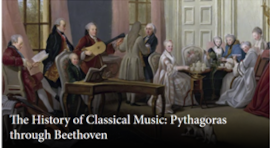Hillsdale College’s free online course, The History of Classical Music, is taught by Hyperion Knight, a gifted pianist and teaching fellow at the college. The course consists of four lectures and a concert plus short, supplementary videos and quizzes. Knight’s lectures include many images along with frequent musical excerpts he plays on the piano. For the 46-minute concert, Knight plays several pieces, such as J.S. Bach’s “Jesu, Joy of Man’s Desiring” and Pachelbel’s Canon in D Major.
As he begins teaching about the history of classical music, Knight explains that the development of music lagged behind the other fine arts. Pythagoras first recognized the octave and the mathematical relationships between notes, including the rates at which strings vibrate as notes are played. Knight credits the development of mathematics as the source for understanding music, but it took centuries before Pythagoras’s discoveries had great effect.
In the first lecture, students might feel a bit overwhelmed as Knight discusses math and music theory at a level likely beyond the novice musician’s ability to understand. They should absorb what they can and not worry about the rest. They are not tested on their knowledge of music theory, and they don’t need to fully understand the theory to get great value from the course. There’s less discussion of theory in the rest of the lectures. (Those who want a more thorough explanation of the theory should go to the Discussion tab for this lesson, find the topic “Too deep for novice,” and then scroll down to Professor Knight’s lengthy post.)
In a later lecture, Knight discusses the mathematical relationships that explain how we arrived at all the major and minor keys. Again, students don’t have to fully understand this to get the main idea that there is mathematical logic to music.
Because of the music theory explained via the piano keyboard, this course is best for students in high school and above who are already familiar with the keyboard. Those lacking that knowledge might understand less theory, but they will still learn the history of the development of classical music—the main point of the course.
As Knight continues with the history, he explains the huge advancement in music that resulted after Charlemagne advocated a uniform plainchant for monks to provide a consistent form of written music. Written musical notation gradually developed into much greater complexity to convey consistent ways to sing or play.
I think the course becomes increasingly interesting as it progresses. It covers topics such as the development of the piano, the difference between a sonata (a piece played) and a cantata (a piece sung), and the development of the opera. We meet famous composers along the way, such as Haydn, Mozart, Bach, and Beethoven.
Little-known historical facts enliven the course. For instance, most people are aware that George Frideric Handel was motivated by his Christian faith but don’t know that his Messiah was first performed to raise money to liberate convicts from debtor’s prison in Ireland. We learn that Joseph Haydn developed the four-movement symphony and was a mentor to Beethoven. We also learn of Ludwig van Beethoven’s admiration for Napoleon Bonaparte, which was destroyed when Napoleon crowned himself emperor rather than support the rise of democracy. These are just a few examples of the way Knight ties in the current cultural situation, religious beliefs, political developments, and personal lives of composers. Tying into modern times, Knight occasionally plays a riff from a modern piece of music that is based on a classical piece.
Two or three supplemental videos for each of the four lectures run just a few minutes each. In these, Knight addresses narrow questions such as “What makes a composer great?” They offer fascinating sidelights and shouldn’t be skipped.
A five-question quiz follows each of the first four lectures, and there’s a final, ten-question quiz at the end of the course.
The online “study guide” for each lecture outlines the content and lists optional music for students to listen to.
The History of Classical Music works best as a supplement within a fine arts course for high school. Watching the lectures, concert, and supplemental videos and taking quizzes can be completed in fewer than five hours. Optional listening can add more hours to the course, but it still doesn’t provide enough hours for more than a supplemental role. On the other hand, that makes it easy to plug this course in whenever you please.
Summary
The History of Classical Music is inspiring once you get past the theory discussion in the first lecture. I loved listening to Knight play the various excerpts as well as the concert in Lesson 5. Aside from what students learn, just listening to so much glorious music is itself a delight. I’ll summarize with Knight’s own words:
“In music you also find a spiritual component that is simply beyond words, and that’s a little hard to define because it’s not expressed in words. But nonetheless, it is there. There is nothing more powerful or moving than Beethoven’s Ninth Symphony or Bach’s St. Mathew Passion or any number of great masterpieces that elevate us to another level.” (“Why should we study classical music?” supplemental video for Lesson 4).









